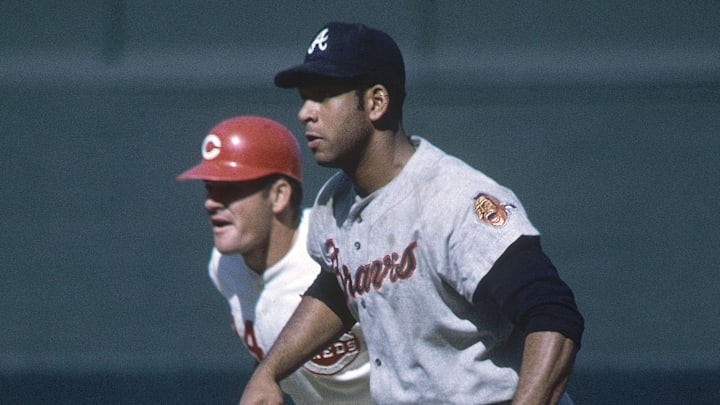On March 17, 1969, the Cardinals sent Orland Cepeda to Atlanta for Joe Torre and both teams got what they wanted. Cepeda might have remained a Giant forever, except for two things: bad knees and Willie McCovey. From 1958 to 1964, Cepeda averaged 32 homers a season and batted .309/.354/.537 with a 141 OPS+ for San Francisco, absent his injured knees.
Cepeda could have moved to left field and McCovey could have taken first base, but knee surgery cost him the 1965 season, and 19 games into the 1966 season, the Giants sent him to St Louis for Ray Sadecki.
Cepeda came alive in St Louis. The Giants didn’t like his Latin music, and joking around, but the Cardinals embraced it. Orlando commented, “You know... if I do all this in San Francisco they would give me a funny look all the time and everyone would think there is something wrong with me.”
The Sadecki trade was then and remains today one of the dumbest trades in baseball history. Sadecki was a Giant through 1969, posting a 32-39 record. Fangraphs gives him 8.6 fWAR as a Cardinal, while baseball reference gives him 3.1.
Meanwhile, in Cepeda's first two years in St Louis, he batted a combined .314/.381/.500 capped by a .325/.399/.524 line with a .923 OPS in 1967 to become the first unanimously selected NL MVP since Carl Hubble in 1936. He accumulated a11.1 fWAR, an 11 rWAR -, and led the Cardinals to the World Series title.
Yep, a dumb, dumb, diddly-do-do dumb trade.
For the first time in his career, Cepeda struggled to reach a .685 OPS in 1968, the first OPS under .800 of his career. The Cardinals panicked and eventually sent him to the Atlanta Braves.
Orlando Cepeda was a welcome sight for the Braves
The Atlanta Braves have been blessed with a few outstanding first basemen and Hall of Famer Orlando Cepeda is among the best to play in Atlanta. Like Fred McGriff, Cepeda wasn't in Atlanta long but he left an indelible mark on the team's history.
Early in his career, Cepeda faced racism at every turn. Originally signed by the Pirates, living conditions with their minor league team were so bad he didn’t hit, and they released him. One of his managers with the Giants – Alvin Dark - was openly hostile to Latin American players and clashed with Cepeda often.
Cepeda expanded on this experience stating, "…my knee was hurt. Dark thought I was trying not to play. He treated me like a child. I am a human being, whether I am blue or black or white or green. We Latins are different, but we are still human beings. Dark did not respect our differences.”
Cepeda loved St. Louis and the idea of playing in the South made him uneasy. However, those feelings quickly evaporated when he was met by his old friend and former roommate Felipe Alou and Braves icon Henry Aaron.
The 1969 season saw Cepeda rebound slightly and he posted a.753 OPS, smacked 28 doubles, two triples, and 22 homers as the Braves won the NL West in the first season of divisional play.
The Miracle Mets swept the Braves out of the NLCS but Cepeda did his best to prevent it, going 5-for-11. He drove in three runs and hit a homer off Nolan Ryan in game three, finishing with a gaudy .455/.539/.909 line with a 1.448 OPS.

The 1970 season saw Cepeda once again terrorizing pitchers. His 33 doubles were good for 12th in the NL, his 34 homers tied him for seventh, and his 111 RBI ranked eighth.
He opened the 1971 season on pace for his best performance in 11 years. After 46 games, Cha-Cha had crushed 13 homers, nine doubles, one triple, drove in 35 runs, and batted .303/.364/.584 with a .948 OPS. He had cooled off a little by June 16 but was still among the league leaders when he got up to answer his phone, and his left knee collapsed.
The Braves ended up trading him to the Athletics at the end of June 1972. He tried to play a few times but only appeared in three games before needing season-ending knee surgery.
Orlando spent four seasons with the Braves spanning from 1969 to 1972. During that time, he batted .280 with 414 hits including 74 doubes, three triples, 74 homers, and 252 RBI. The trade for Cepeda was everything the team could have hoped for.
The injury to his left knee effectively ended his days as a two-way player. According to an article on SABR, "The Braves doctor told him the knee was “finished.” He hobbled out to first base for a few weeks before finally shutting it down in late July. He underwent another knee surgery in September and went home to Puerto Rico."
It seemed Orlando was headed for retirement until the AL decided to experiment with the designated hitter and the Red Sox signed Cepeda to fill that role and he did it very well. He batted .289/.350/.444 with 25 doubles, 20 home runs, and a .793 OPS on his way to winning the first Designated Hitter of the Year award.
The Baby Bull was the second Puerto Rican to reach the big leagues and the first elected to an All-Star team. He would appear on 11 All-Star teams in seven years (there were two ASG a year for a while).
When Cha-Cha Cepeda quit playing first base, he’d accumulated a 48.4 rWAR, good for seventh behind Hall of Famers Lou Gehrig, Jimmie Foxx, Johnny Mize, Willie McCovey, Bill Terry, and Hank Greenberg, but didn’t receive his plaque until 1999.
The staff at The House That Hank Built sends our thoughts and condolences to the Cepeda family. He was a very special player and person.
